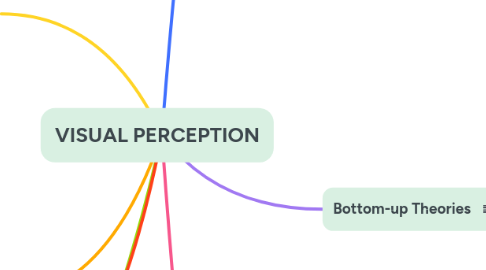
1. Deficits in Perception
1.1. Agnosia
1.2. Prosopagnosia
1.3. Ataxia
2. Perception
2.1. James Gibson's Framework
2.2. Sensory Adaptation
2.2.1. "Ganzfeld"
2.3. What/Where Hypothesis
2.3.1. Where Pathway
2.3.2. What Pathway
2.3.3. Alternative Interpretation of the Visual Pathways
2.4. Objects and Forms
2.4.1. Viewer-Centered Perception
2.4.2. Object-Centered Perception
2.4.3. Landmark-Centered Perception
3. Perceptual Constancies
3.1. Size Constancy
3.2. Shape Constancy
4. Depth Perception
4.1. Binocular Depth Cues
4.2. Monocular Depth Cues
5. Mental Precept
5.1. Visual System
5.1.1. Cornea
5.1.2. Iris
5.1.3. Pupil
5.1.4. Crystalline lens
5.1.5. Vitreous humor
5.1.6. Fovea
5.1.7. Retina (Three Main Layers)
5.1.7.1. Ganglion Cells
5.1.7.2. Interneuron Cells
5.1.7.3. Photoreceptors
5.1.7.3.1. Rods
5.1.7.3.2. Cones
6. Bottom-up Theories
6.1. Direct Perception
6.1.1. Hoffding Function
6.1.2. Gibson's Theory
6.1.3. Ecological Perception
6.2. Template Theories
6.2.1. **Templates ** are highly detailed models for patterns we potentially might recognize. We recognize a pattern by comparing it with our set of templates. We then choose the exact template that perfectly matches what we observe.
6.2.1.1. Examples
6.3. Feature Matching Theory
6.3.1. Oliver Selfridge's Pandemonium Model
6.3.1.1. In it are metaphorical “demons” with specific duties receive and analyze the features of a stimulus.
6.3.1.2. Four Demons
6.3.1.2.1. Image
6.3.1.2.2. Feature
6.3.1.2.3. Cognitive
6.3.1.2.4. Decision
6.3.2. Global Precedence Effect
6.3.2.1. Local Features
6.3.2.2. Global Features
6.3.3. Local Precedence Effect
6.4. Recognition-by-Components Theory
7. Top-down Theories
7.1. Configural-Superiority Effect
7.2. Object-Superiority Effect
7.3. Word-Superiority Effect
7.4. Gestalt Principles
7.4.1. Proximity
7.4.2. Similarity
7.4.3. Continuity
7.4.4. Closure
7.4.5. Symmetry
7.4.6. Figure Ground
